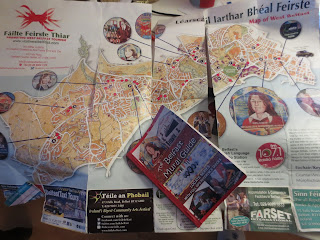As already said, the trip on Ireland was my first real solo trip....and I was a little scared, mostly of feeling lonely...or that something could have gone wrong..etc..
I did not tell a lot of people of this trip....superstitious reasons? maybe ...(well, the KLM flight cancelled the day before leaving was an input to this decision..;) ;)).....I did not share in the social network anything of my trip...and the main reason was that I wanted to live the trip really deeply and no need to 'social' sharing experiences, eventually I would have preferred sharing it with real people met during the trip...;)
And even less people known of this blog...I was not sure about its longevity ;), and if I had the time to write on it (which in fact I did not had!)...
But there were some special people who, for one reason or another, known almost all and cared how I was up there...so the dinner was for them (who also consciously played the role of tester...anyway fettuccine and sauce were at hand)...even if a couple of them were missing!! :)
PS: I love the look of this post ....;)....I feel a little like my friend Naima of Cucino da Vicino who cooks and writes sensations....(Naima, this is free publicity eh! ;* ;*)
So the DINNER.... :)
Irish dinners often begin with bread and butter....
The typical bread is the
SODA BREAD
(Irish: arán sóide)
According to Lonely Planet, the soda bread born in the XIX century as consequence of the characteristic of the Irish flour to be "impalpable" which did not ensure good final results if mixed with the common yeast.
So in place of the yeast, the bakers began to use the sodium bicarbonate (also known as baking soda) which reacts with the acidity of added lactic acid, giving tiny bubbles of carbon dioxide (- and also the chemistry lesson is done ;) -).....these bubbles act as leaving agent...
My recipe of (brown) soda bread comes from some pages of an old magazine which I stored (- see mammy why I do not throw away anything???.;) -) ...specifically I Viaggi di Repubblica of 27 April 2000 ....(oh my God, the fact that I do not live in Rome anymore means that my life there stopped more or less when I left ;))....
Ingredients:
500 gr of whole wheat flour
500 gr of white flour
around 15 gr of salt
around 13 gr of sodium bicarbonate
800 ml of sour cream (panna acida in Italian)...this is the most expensive ingredient...I think 800 ml will cost you around 5.5 euro...- in Luxembourg)
25 gr of butter
How to prepare the bread:
25 gr of butter
How to prepare the bread:
Mix the two flours with the bicarbonate and the salt.
Add the butter and the cream...mix all the ingredients quite fast until the dough becomes soft and compact.
Give a nice shape, cut a deep cross on the surface to let the reaming bubbles to go out during the cooking, and put in the pre-heated oven for 30-35 minute at 200 °C (around 185 °C for a convection oven)..before turning off the oven check that it is light brown outside and that it makes a sound vacuum!
 |
| ready for the oven (photo taken with compact camera) |
The result :):
My friends loved it....I had never seen before Manu eating so happily ;)
Suggestions:
This bread is perfect as salty bread (with the soup is fantastic) with butter on the top...but try also with butter and jam..you will never forget it! :)
Alternative recipes
(in Italian):
(In Irish and English...as suggested by an Irish colleague :)...thanks! :))
http://blogs.transparent.com/irish/oideas-i-ngaeilge-aran-soide-eireannach-agus-aistriuchan-bearla-and-an-english-translation/











